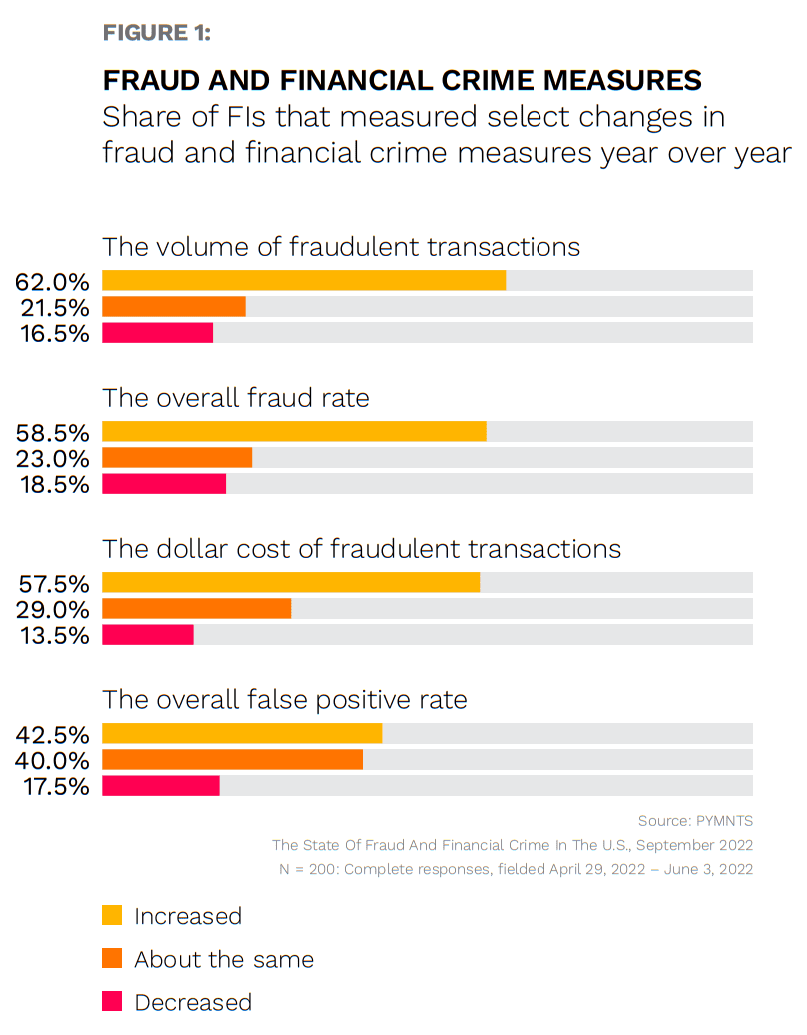The Many Faces of Fraud Haunt a Beset Holiday Selling Season

To borrow from an old holiday chestnut, ‘tis the season for financial scams and cheaters, as the wicked work of fraudsters gets an added bump from consumer fraud that tends to tick up during the holidays, and even more so in a gifting season set in a depressed economy.
From big-time bank-level financial scams to subscription “cheaters” accessing services they don’t pay for with someone else’s credentials to first-party fraud where consumers abuse promotions and chargebacks, the payments sphere makes the most tempting of targets.
Starting with the “steal big” ethos, in “The State Of Fraud And Financial Crime In The U.S.,” a PYMNTS and Featurespace collaboration based on a survey of 200 executives at financial institutions with assets of at least $5 billion, we found that 62% of all FIs experienced an increase in financial crime in 2022, with smaller FIs (between $5 billion and $25 billion in assets) particularly seeing an increase in the dollar value of fraudulent transactions.
The big takeaway from that study: “FIs that employ ML-, AI- or cloud-based platforms to mitigate fraud risk had the smallest shares of transactions lead to fraud losses among respondents to our survey. Overcoming implementation challenges can thus make a sizable impact in overall fraud-fighting effectiveness.”

Read the Study: The State Of Fraud and Financial Crime In The U.S.
Fraud Isn’t Friendly
Moving on to what’s referred to by the misnomer “friendly fraud,” Yinglian Xie, CEO of DataVisor said in a recent Digital Fraud Tracker® that “While not identical in meaning, policy abuse, promo abuse, first-party fraud, friendly fraud, and similar issues share an identity in the fact that they are illicit acts perpetrated by individuals who don’t necessarily hide or misrepresent their identities,” and legacy systems have trouble sniffing this out.
Xie noted that “traditional fraud-prevention measures and tools are not great at detecting policy abuse because they are designed to look for instances where identities, credentials, and payment methods are compromised, as is not the case with these issues.”
To fight this insider fraud, Xie said first-party fraud must be seen for what is — theft — and not merely “a cost of doing business, a customer support issue or another type of matter.” She added that ownership of policy abuse in organizations must be clarified with “company-wide strategies designed to ensure that policies are effective” and to migrate away from transaction level-only detection, “which by itself is incapable of detecting most forms of policy abuse.”
Get Your Copy: Digital Fraud Tracker®
Cheaters Never Win, But Many Watch for Free
As streaming platforms exploded in popularity over the past decade, the practice of letting family and friends who are not subscribers use one’s credentials has become commonplace, which subscribers have usually seen as a victimless crime.
That’s not very considerate for one thing, but more to the point, it’s against the rules. In its first quarter 2022 shareholder letter, Netflix said in its 222 million paying households, “we estimate that Netflix is being shared with over 100 [million] additional households, including over 30 [million] in the UCAN region.”
It led to a crackdown on sharing, but the problem is bigger than one platform. In the September “Subscription Commerce Conversion Index: The Challenge Of Cheaters,” a PYMNTS and sticky.io collaboration, a survey of over 2,000 U.S. consumers found that “More consumers are using subscriptions paid by their friends, family or employers. A majority of Generation Z subscribers and those living paycheck to paycheck who have issues paying their bills have others pay their subscription fees: 51% and 61% of these groups do so, respectively.”
The study added that “The incidence of cheaters varies little across age groups, with one exception. Sixty-nine percent of millennial, bridge millennial, and Gen Z consumers self-identified as cheaters, followed by 63% of Generation X consumers. However, whether out of ethics or a lack of tech-savviness, only 16% of baby boomers and seniors admitted to cheating.”

Get Your Copy: Subscription Commerce Conversion Index: The Challenge Of Cheaters
